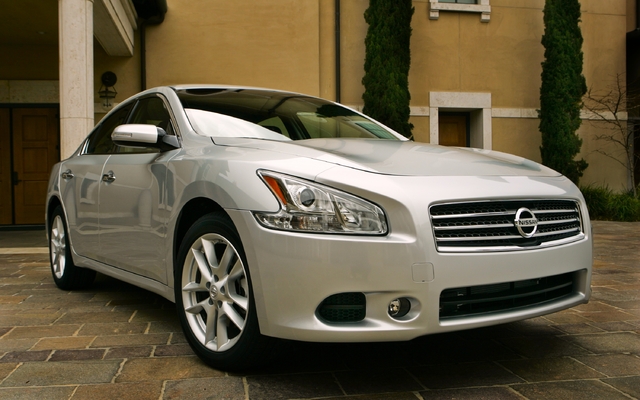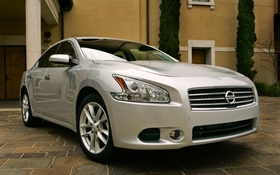2011 Nissan Maxima: Z DNA?

| Strong points |
|
|---|---|
| Weak points |
|
It sure is entertaining, that Nissan Maxima commercial in which a 370Z is stretched out, gets two more doors and morphs into a Maxima while a voice tells you that the Maxima is really a sedan version of the Z. Right. In my opinion, the Maxima would need a lot more than two extra doors to be considered a Z sedan. For instance, consider the major difference between the two vehicles: the Z has rear-wheel drive wheras the Maxima has front-wheel drive.
The late 1990s were the glory days of the Nissan Maxima, while it was in its fourth generation. It offered a good level of luxury and comfort, but more importantly it featured great performances given the asking price. Then, for two reasons, Maxima sales started to decline. First of all, the more affordable Altima moved to the fore as a more appealing alternative. Furthermore, the arrival of Nissan’s high-end division, Infiniti, made life harder for the Japanese manufacturer’s luxury sedan. For a similar price, people preferred to buy themselves a more prestigious brand name. Today, the G37 sedan sells for $1,000 less than the Maxima. It’s hard under the circumstances to attract buyers – especially since the G37 turned out to be a superior automobile on many levels.
A single choice
Nissan refined the number of trim levels over the years, and in 2011, buyers are left with just one choice – the Maxima 3.5 SV. It has the most famous Nissan engine under its hood, namely the tireless 3.5-litre V6 that delivers 290 horsepower at 6,400 rpm for 261 lbs-ft of torque at 4,400 rpm, which is more than reasonable power for this four-door sedan. But for $1,000 less, the G37’s 3.7-litre V6 offers 328. You see where I’m going with this?
One of the Nissan Maxima’s plusses is its style. The Maxima is a good-looking car, and it’s a good thing, too, because while logic may not favour the Maxima, its looks could win over a few customers. The current generation, which arrived in 2009, is a lot better than the previous one. More importantly, it’s also less anonymous. We like its sportier and more modern design. It’s got more presence and is very easy on the eyes. The front end, inspired by the manufacturer’s sport models like the GT-R, is gorgeous. Kudos to the designers for their work on the headlights and the hood. The car looks even better with the Sport Package, which comes with several extra aesthetic features, such as 19-inch rims.
The Infiniti’s influence
Inside, certain features are so similar to the Infiniti that you start wondering which car you’re in – especially the multifunction display and its control panel with nearly horizontal control layout. The advantage of this similarity is that the Maxima’s passenger compartment obviously great and incredibly sporty. The quality of the materials and assembly are practically beyond reproach, and the same goes for the Maxima’s three-spoke steering wheel. If you close your eyes, you’d swear you were at the wheel of an Infiniti G.
Bigger than the Infiniti G, the Maxima’s passenger compartment is very roomy and comfortable. That’s another positive point for the Maxima, especially for those who like big sedans. There’s lots of room for passengers – three adults would easily fit in the back, which is rare these days. You’d think that it would be the same for the cargo hold, but the trunk design cuts the space slightly. First of all, the size of the opening limits the possibility, or at least the facility, of loading larger objects, such as hockey bags. What’s more, the suspension turrets also encroach on the cargo space. Basically, there’s more space than on many other sedans, but it could’ve been even better. Finally, of the two possible bench configurations (the 60/40 fold-down bench or the fixed version with trunk pass-through) you’re better off selecting for the more practical fold-down option.
On the road
First off, the Maxima handles more like a touring car than a sport sedan. Despite its precise steering, its suspension is calibrated a lot more for comfort than for handling. Some people definitely prefer it that way. In spite of the Maxima’s weight, the engine provides ample power to move this big sedan. When you press the accelerator, it engages right away, but with significant torque effect. The front wheels try to go left and right, and this is even more pronounced on uneven ground. And as you know, Canadian roads have a reputation for imperfections, and this car is constantly looking to follow the slightest bump.
The 3.5-litre V6’s 290 horses are sent to the wheels by way of a CVT automatic gearbox. I’ve always found it hard to get used this type of transmission, especially when the car is supposed to be sporty. Nonetheless, I must admit that Nissan probably offers the best type of CVT, or at least the CVT that is best programmed to mimic a classic automatic transmission. Manual mode and controls behind the steering wheel give you the chance to control the gears and rpm as you see fit. As for fuel consumption, Nissan has come up with some very attractive figures – 10.9 L/100 km in town and 7.7 L/100 km on the highway. However, I calculated an average of 11.5 L/100 km during a cold snap.
The 2011 Nissan Maxima isn’t a bad car. It offers several attractive features, but its market positioning isn’t making life any easier. The fact that there’s no all-wheel drive version is also working against it, especially considering how popular AWD is in Canada.











